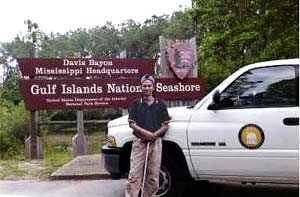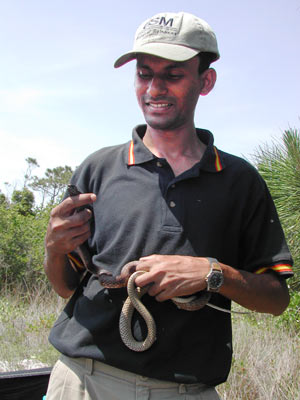|
Asian Scholarship recipient A.H.M. ALI REZA is a lecturer in the Department of Zoology at Jahangirnagar University, Dhaka, Bangladesh. In 2001, he lead a survey to assess the population of the marine turtles along the sea beaches of the Sundarbans mangrove forest and recorded 25 dead adult olive ridley turtle in an area of approximately 1 square kilometer. Reza and fellow university students have joined in an effort to convince local fishermen to release marine turtles as soon as they are captured. The fishermen do not as yet use TEDs (Turtle Excluder Devices).

Upon his arrival in the U.S., Reza participated in a herpetological survey on Santa Rosa Island (Florida) and at the Davis Bayou National Seashore (Mississippi), both parts of the Gulf Island National Seashore. The following are his notes from the experience:
Experience in the Gulf Island National Seashore,
in Southern Mississippi & Northern Florida

By AHM Ali Reza
 |
 |


Reza at Davis Bayou National Seashore
 |
|
Everything is very new to me and I am enjoying my surroundings: the car drive, nice one-way highways, roadside gas stations, food shops, pine forests, and the mysterious evening. It was just the day before yesterday I landed in the United States, and this is my first ever travel outside Asia. After a short while in Philadelphia with ASP Director William Espenshade, I came down to southern Mississippi to assist a herpetological survey on some barrier islands and mainland sites at the Gulf Island National Seashore (GINS). This will be part of the academic research by Tom Mohrman, a graduate student of the University of Southern Mississippi (USM). I don't know anything about my destination this evening, but was informed earlier that we are going to camp on an island for the next four to five days. I am sitting right next to Tom; he has been driving for the last four hours to get to a part of the GINS called Santa Rosa Island, which is in Florida.
We reached Santa Rosa Island at about 7:15 in the evening. As soon as we got to the island, Tom talked to the National Park authority to finalize our overnight stay in the campground. Eventually, we went to Tom's sampling sites to check the condition of the drift fences and other traps set to capture the herpetofauna. We set some minnow traps in some freshwater pools.
These are mostly used for fishing, but here we are using these traps to capture some water snakes. When I saw the minnow traps I was not fully convinced that we could capture any snakes with these traps. We set 25 minnow traps in various freshwater pools on the island, checked the drift fence, set 8 box and funnel traps, and then went back to our camping site. The campground was very interesting to me, as I never visited such a place before. I cannot even imagine that so many people would spend their nights out of their house to have fun. This is really awesome!
The very next day, in the early morning, we went to check our fences and traps. I was really impressed when I found two-banded water snakes in the minnow traps. Tom recorded all the necessary morphometric and other data for the snakes and 3 southern toads, which we captured in our pitfall traps. On the way back to our other fences, in the dune grasslands, very close to the highway, I found a pretty black snake was basking on the ground. I immediately informed Tom and we together captured the snake by our snake tong. Tom identified the snake as black racer.
As we are living in the field and doing fieldwork, our regular food menu mainly consisted of either sandwiches or hotdogs. As we had to preserve our food in an icebox, most of our food loses its real taste. But it's a lifetime experience for me to work in place like the Gulf of Mexico. The next morning we again went back to check our fences and traps. A huge eastern coachwhip was trying to pass one of the drift fences. As we approached the snake, it crossed the fence within a fraction of second. I could not believe that a snake could be so fast. I became frustrated not to catch the coachwhip this time, but in the very next morning, we captured the coachwhip in one of our funnel traps. I was pleased to see the snake in my hand. In total, we recorded 9 herpetofauna in our five-day sampling time. Notable among them were: narrow-mouth toad, squirrel tree frog, green tree frog, and southern leopard frog. I am now confident I could at least identify some herps in this southern part of U.S.
 |


A coachwhip snake in hand
 |
|
After taking two days off, we started for our next sampling area, the Davis Bayou National Seashore, which is also a part of GINS. It takes two hours from Hattiesburg (home of USM) to get on to the Seashore. This is a very small park, but it has more diversified habitat than Santa Rosa Island. During our fieldwork, weather was not favorable. It was raining most of the time. It would be rather difficult to find more reptiles in such an environment, we guessed. By the way, we were lucky enough to record 21 species of herpetofauna in our five-day survey. The most important one among these was the narrow-mouth toad, because no one had reported this species before from the park. One notable point in this site is that we captured at least 30 two-toed amphiuma in our minnow traps. This giant salamander lives in stagnant, shallow waters. We also recorded 7 species of frog from this small park. One of the notable turtle species we recorded during this time was a giant common snapping turtle. This was the very first time that I saw a snapping turtle. We captured that turtle by our hoop net, a special type of net trap used mainly for capturing big to medium-sized aquatic animals. We also captured some snakes, lizards, and salamanders, which all are very new to me. It was really remarkable that such a small area could support this high species diversity. During these five days I felt some sort of attraction to the park, and if time permitted, I could have spent more time here. Anyway, everything comes to an end, our trip was finished, and we are now moving towards the city from where we started. But I would love to be back here again.
|